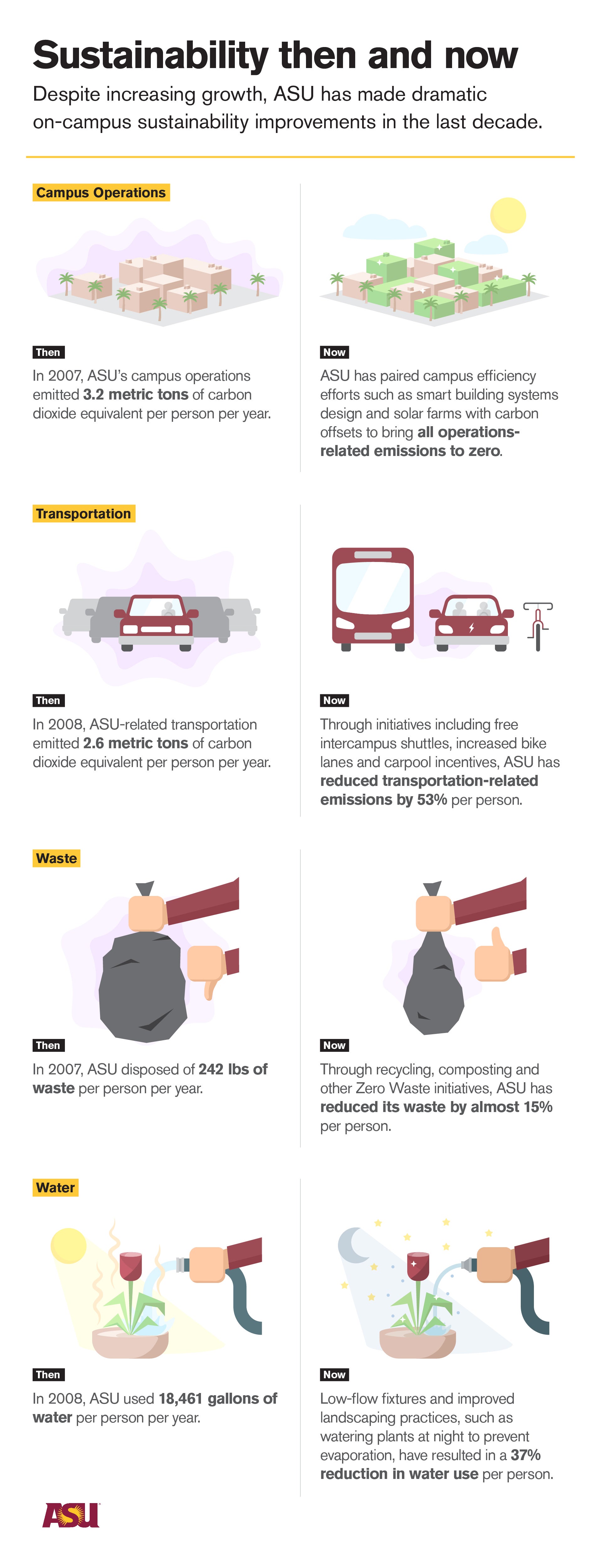ASU achieves carbon neutrality, ranked among most sustainable universities in the world

Carbon dioxide emissions likely will decrease in 2020 in the wake of COVID-19 and shelter-in-place orders. However, those emissions surely will rise again once the pandemic passes unless significant steps are taken to tackle human-caused climate change.
In 2007, Arizona State University was ahead of the curve when it came to reducing greenhouse gas emissions. That’s when ASU pledged to reach zero greenhouse gas emissions from campus operations by 2025. To underscore the urgency to act, ASU reached that goal six years early — on June 30, 2019.
Increased energy efficiency in both new buildings and campus retrofits; on-site solar generation; renewable energy purchases from large-scale, off-site generation facilities; and purchase of carbon offsets and renewable energy were all deployed while growing the student population and undertaking a physical expansion of all ASU’s campuses.
This action is one key element of many initiatives that have helped ASU also earn the STARS (Sustainability Tracking, Assessment and Rating System) Platinum sustainability rating from the Association for the Advancement of Sustainability in Higher Education. STARS is a framework for colleges and universities to measure their comprehensive sustainability performance.
Platinum is the highest certification awarded in the STARS program and ASU is one of only six universities in the world to achieve the STARS Platinum rating.
“Our goal is to make sustainability innovation and leadership a hallmark of Arizona State University,” ASU President Michael Crow said. “ASU’s ambitious choice to pursue climate neutrality and our early realization of that aspiration, as well as our success in earning a STARS platinum rating, demonstrate the comprehensive commitment of our university community to lead in sustainability education, operation and practice.”
“The commitment to reducing ASU’s carbon footprint is an important first step that already has significant impacts,” noted Peter Schlosser, ASU vice president and vice provost of the Global Futures Laboratory. “We are working to ensure that the combination of concrete action and increased awareness of our planet’s boundaries will rapidly translate into more meaningful action on a national and global scale.”
STARS evaluates emissions, facilities, operations, academics, research, planning, engagement, investments and more. Significant clarifications and improvements regarding sustainability in ASU’s academics and investments also contributed to earning Platinum certification, even as the rating system has become more stringent.
ASU has reduced total net emissions by 80% per 1,000 gross-square-foot of building space and 65% per student compared with 2007. Of note, the university has reduced carbon emissions while increasing building space on campuses by 39.5% and the number of on-campus students by 24.3%.
“ASU has a distinguished track record of climate action along with a vibrant culture of sustainability, from serving as an original signatory of the Presidents’ Climate Commitment, to establishing the first and largest School of Sustainability in the country, to playing a key leadership role in launching the commercial solar power purchase agreement marketplace in Arizona,” said Morgan Olsen, ASU executive vice president, treasurer and chief financial officer. “The elite STARS Platinum rating and climate neutrality are major milestones in ASU’s leadership in helping society move toward sustainability and thoughtful stewardship of our planet.”
Mick Dalrymple, director of University Sustainability Practices and a senior sustainability scientist, added that ASU will continue to seek out opportunities to strengthen its climate neutrality such as electrifying ASU’s fleet, exploring additional collaborations with utility and energy technology companies, expanding alternative transportation and telecommuting programs, planting a native forest carbon sink at ASU's West campus, and implementing a carbon neutral new construction policy.
ASU’s additional operational climate goals include reaching neutrality for emissions related to commuting and air travel by 2035.
With many other ongoing initiatives, ASU will also continue to work on improving its overall sustainability as measured by STARS and ASU’s eight sustainability goals.
“We seek to serve as both a ‘living laboratory’ and a living example of sustainability to demonstrate to our communities and the world what is possible with dedication and innovation,” Dalrymple said.
Graphic by Alex Davis/ASU Media Relations and Strategic Communications
More Environment and sustainability

Public education project brings new water recycling process to life
A new virtual reality project developed by an interdisciplinary team at Arizona State University has earned the 2025 WateReuse Award for Excellence in Outreach and Education. The national …

ASU team creates decision-making framework to improve conservation efficiency
Conserving the world’s ecosystems is a hard job — especially in times of climate change, large-scale landscape destruction and the sixth mass extinction. The job’s not made any easier by the fact…

Mapping the way to harvesting water from air
Earth’s atmosphere contains about 13 trillion tons of water.That’s a lot of water to draw upon to help people who are contending with drought, overtaxed rivers and shrinking aquifers.In fact,…


